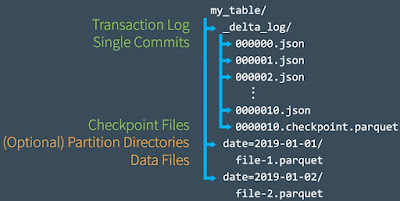Delta Table's Files
In a previous post, I tested the CRUD operations against a Microsoft Fabric's delta table. To view the files behind, you'll need to navigate to the Lakehouse, right click on the Assets table and pick 'View files' from the floating menu:
 |
| Assets' delta table files in Lakehouse |
One can navigate within the folder structure, look at the transaction log files under _delta_log folder, though there seems to be no way to download the respective files. For this purpose, alternatively, you can use the Azure Storage Explorer (downloadable here). After installing the Explorer use the 'ADLSGen2 container or directory' option to connect to the folder where the Assets table was created (see [1]).
 |
| Assets' delta table files in Azure Storage Explorer |
And, here's the content of the _delta_log from where the files can be downloaded:
 |
| Assets' log files in Azure Storage Explorer |
{"commitInfo":{"timestamp":1707006399711,"operation":"CREATE TABLE","operationParameters":{"isManaged":"true","description":null,"partitionBy":"[]","properties":"{}"},"isolationLevel":"Serializable","isBlindAppend":true,"operationMetrics":{},"engineInfo":"Apache-Spark/3.4.1.5.3-110807746 Delta-Lake/2.4.0.8","txnId":"c3e6f24e-fa78-4941-a29d-28aac3a25926"}} {"protocol":{"minReaderVersion":1,"minWriterVersion":2}} {"metaData":{"id":"a9a45d67-bcf9-4bef-8f48-c6b8f7a64f58","format":{"provider":"parquet","options":{}},"schemaString":"{\"type\":\"struct\",\"fields\":[ {\"name\":\"Id\",\"type\":\"integer\",\"nullable\":false,\"metadata\":{}}, {\"name\":\"CreationDate\",\"type\":\"timestamp\",\"nullable\":false,\"metadata\":{}}, {\"name\":\"Vendor\",\"type\":\"string\",\"nullable\":false,\"metadata\":{}}, {\"name\":\"Asset\",\"type\":\"string\",\"nullable\":false,\"metadata\":{}}, {\"name\":\"Model\",\"type\":\"string\",\"nullable\":false,\"metadata\":{}}, {\"name\":\"Owner\",\"type\":\"string\",\"nullable\":false,\"metadata\":{}}, {\"name\":\"Tag\",\"type\":\"string\",\"nullable\":false,\"metadata\":{}}, {\"name\":\"Quantity\",\"type\":\"decimal(13,2)\",\"nullable\":false,\"metadata\":{}}]}","partitionColumns":[],"configuration":{},"createdTime":1707006399640}}
{"commitInfo":{"timestamp":1707006405806,"operation":"WRITE","operationParameters":{"mode":"Append","partitionBy":"[]"},"readVersion":0,"isolationLevel":"Serializable","isBlindAppend":true,"operationMetrics":{"numFiles":"1","numOutputRows":"1","numOutputBytes":"3713"},"tags":{"VORDER":"true"},"engineInfo":"Apache-Spark/3.4.1.5.3-110807746 Delta-Lake/2.4.0.8","txnId":"ac51fa78-8384-4e53-bb02-40d65632a218"}} {"add":{"path":"part-00000-b50df7ae-66d8-41fd-a54d-6238e053d269-c000.snappy.parquet","partitionValues":{},"size":3713,"modificationTime":1707006405683,"dataChange":true,"stats":"{\"numRecords\":1,\"minValues\": {\"Id\":1,\"CreationDate\":\"2024-03-01T00:00:00.000Z\",\"Vendor\":\"IBM\",\"Asset\":\"Laptop 1\",\"Model\":\"Model 1\",\"Owner\":\"Owner 1\",\"Tag\":\"XX0001\",\"Quantity\":1.00},\"maxValues\":{\"Id\":1,\"CreationDate\":\"2024-03-01T00:00:00.000Z\",\"Vendor\":\"IBM\",\"Asset\":\"Laptop 1\",\"Model\":\"Model 1\",\"Owner\":\"Owner 1\",\"Tag\":\"XX0001\",\"Quantity\":1.00},\"nullCount\":{\"Id\":0,\"CreationDate\":0,\"Vendor\":0,\"Asset\":0,\"Model\":0,\"Owner\":0,\"Tag\":0,\"Quantity\":0}}","tags":{"VORDER":"true"}}}
The third file holds the content for inserting the multiple lines, while the fourth file contains the content for the UPDATE statement:
{"commitInfo":{"timestamp":1707006417538,"operation":"UPDATE","operationParameters":{"predicate":"[\"(Id#1952 = 6)\"]"},"readVersion":2,"isolationLevel":"Serializable","isBlindAppend":false,"operationMetrics":{"numRemovedFiles":"1","numRemovedBytes":"3870","numCopiedRows":"4","numAddedChangeFiles":"0","executionTimeMs":"2297","scanTimeMs":"1613","numAddedFiles":"1","numUpdatedRows":"1","numAddedBytes":"3870","rewriteTimeMs":"681"},"tags":{"VORDER":"true"},"engineInfo":"Apache-Spark/3.4.1.5.3-110807746 Delta-Lake/2.4.0.8","txnId":"70f0f718-331a-48fc-8419-9f80599ca889"}} {"remove":{"path":"part-00000-0bd7b054-1bde-44cd-a852-80332d98ae8b-c000.snappy.parquet","deletionTimestamp":1707006417533,"dataChange":true,"extendedFileMetadata":true,"partitionValues":{},"size":3870,"tags":{"VORDER":"true"}}} {"add":{"path":"part-00000-b5e4e62f-c938-4db9-a83a-d85850f310c0-c000.snappy.parquet","partitionValues":{},"size":3870,"modificationTime":1707006417436,"dataChange":true,"stats":"{\"numRecords\":5,\"minValues\":{\"Id\":2,\"CreationDate\":\"2024-01-01T00:00:00.000Z\",\"Vendor\":\"Dell\",\"Asset\":\"Laptop 2\",\"Model\":\"Model 2\",\"Owner\":\"Owner 2\",\"Tag\":\"DD0001\",\"Quantity\":1.00},\"maxValues\":{\"Id\":6,\"CreationDate\":\"2024-02-01T00:00:00.000Z\",\"Vendor\":\"Microsoft\",\"Asset\":\"Laptop 4\",\"Model\":\"Model 4\",\"Owner\":\"Owner 4\",\"Tag\":\"XX0001\",\"Quantity\":1.00},\"nullCount\":{\"Id\":0,\"CreationDate\":0,\"Vendor\":0,\"Asset\":0,\"Model\":0,\"Owner\":0,\"Tag\":0,\"Quantity\":0}}","tags":{"VORDER":"true"}}}
The fifth file, holds the content related to the DELETE statement:
{"commitInfo":{"timestamp":1707006422147,"operation":"DELETE","operationParameters":{"predicate":"[\"(Id#2665 = 2)\"]"},"readVersion":3,"isolationLevel":"Serializable","isBlindAppend":false,"operationMetrics":{"numRemovedFiles":"1","numRemovedBytes":"3870","numCopiedRows":"4","numAddedChangeFiles":"0","executionTimeMs":"1425","numDeletedRows":"1","scanTimeMs":"908","numAddedFiles":"1","numAddedBytes":"3837","rewriteTimeMs":"517"},"tags":{"VORDER":"true"},"engineInfo":"Apache-Spark/3.4.1.5.3-110807746 Delta-Lake/2.4.0.8","txnId":"1f61449f-6c4a-40ce-80ed-6ff1a9a834e9"}} {"remove":{"path":"part-00000-b5e4e62f-c938-4db9-a83a-d85850f310c0-c000.snappy.parquet","deletionTimestamp":1707006422134,"dataChange":true,"extendedFileMetadata":true,"partitionValues":{},"size":3870,"tags":{"VORDER":"true"}}} {"add":{"path":"part-00000-bee2e3a5-7def-4466-94ff-ccd86aa37b8c-c000.snappy.parquet","partitionValues":{},"size":3837,"modificationTime":1707006422055,"dataChange":true,"stats":"{\"numRecords\":4,\"minValues\":{\"Id\":3,\"CreationDate\":\"2024-01-01T00:00:00.000Z\",\"Vendor\":\"Dell\",\"Asset\":\"Laptop 3\",\"Model\":\"Model 3\",\"Owner\":\"Owner 2\",\"Tag\":\"DD0001\",\"Quantity\":1.00},\"maxValues\":{\"Id\":6,\"CreationDate\":\"2024-02-01T00:00:00.000Z\",\"Vendor\":\"Microsoft\",\"Asset\":\"Laptop 4\",\"Model\":\"Model 4\",\"Owner\":\"Owner 4\",\"Tag\":\"WX0001\",\"Quantity\":1.00},\"nullCount\":{\"Id\":0,\"CreationDate\":0,\"Vendor\":0,\"Asset\":0,\"Model\":0,\"Owner\":0,\"Tag\":0,\"Quantity\":0}}","tags":{"VORDER":"true"}}}
Before looking at each file, let's note the engineInfo's information that denotes the Spark, respectively the Delta Lake versions: "Apache-Spark/3.4.1.5.3-110807746 Delta-Lake/2.4.0.8". It's important to check these versions against the documentation when troubleshooting!
In each file, besides the "timestamp", observe the values of "operation", "operationParameters", "operationMetrics", "dataChange" and "VORDER".
Operation indicate the DML or DDL statements run. As per my understanding dataChange and VORDER are set to true.
The DESCRIBE HISTORY Command
You can retrieve a history of the actions performed on a table for the past 30 days via the DESCRIBE command, which can be entered in a notebook's cell:-- describe table's history (30 days of data) DESCRIBE HISTORY Assets;
Attributes' definition can be found in [3], see 'History schema' section. For big tables, it might be a good idea to limit command's output only to several records via the LIMIT keyword:
-- describe table's history (30 days of data, last 5 records) DESCRIBE HISTORY Assets LIMIT 5;
-- compacting the files OPTIMIZE Assets;
 |
| Run maintenance commands for a table |
{"commitInfo":{"timestamp":1707150591870,"operation":"OPTIMIZE","operationParameters":{"predicate":"[]","zOrderBy":"[]","auto":false},"readVersion":4,"isolationLevel":"SnapshotIsolation","isBlindAppend":false,"operationMetrics":{"numRemovedFiles":"2","numRemovedBytes":"7550","p25FileSize":"3879","numDeletionVectorsRemoved":"0","minFileSize":"3879","numAddedFiles":"1","maxFileSize":"3879","p75FileSize":"3879","p50FileSize":"3879","numAddedBytes":"3879"},"tags":{"VORDER":"true"},"engineInfo":"Apache-Spark/3.4.1.5.3-110807746 Delta-Lake/2.4.0.8","txnId":"b6466509-9f1a-467d-ad99-a0e95ed694ec"}} {"add":{"path":"part-00000-453e9218-fe59-4138-a7dc-0e71c94c07d2-c000.snappy.parquet","partitionValues":{},"size":3879,"modificationTime":1707150591746,"dataChange":false,"stats":"{\"numRecords\":5,\"minValues\":{\"Id\":1,\"CreationDate\":\"2024-01-01T00:00:00.000Z\",\"Vendor\":\"Dell\",\"Asset\":\"Laptop 1\",\"Model\":\"Model 1\",\"Owner\":\"Owner 1\",\"Tag\":\"DD0001\",\"Quantity\":1.00},\"maxValues\":{\"Id\":6,\"CreationDate\":\"2024-03-01T00:00:00.000Z\",\"Vendor\":\"Microsoft\",\"Asset\":\"Laptop 4\",\"Model\":\"Model 4\",\"Owner\":\"Owner 4\",\"Tag\":\"XX0001\",\"Quantity\":1.00},\"nullCount\":{\"Id\":0,\"CreationDate\":0,\"Vendor\":0,\"Asset\":0,\"Model\":0,\"Owner\":0,\"Tag\":0,\"Quantity\":0}}","tags":{"VORDER":"true"}}} {"remove":{"path":"part-00000-cbaaf2dc-b8d6-44bc-a4e1-97db0ba96074-c000.snappy.parquet","deletionTimestamp":1707150580358,"dataChange":false,"extendedFileMetadata":true,"partitionValues":{},"size":3713,"tags":{"VORDER":"true"}}} {"remove":{"path":"part-00000-6714ec80-1bd8-41f3-b8b7-5197025ec08f-c000.snappy.parquet","deletionTimestamp":1707150580358,"dataChange":false,"extendedFileMetadata":true,"partitionValues":{},"size":3837,"tags":{"VORDER":"true"}}}
Resources:
[1] Microsoft Azure (2023) Azure Storage Explorer (link)
[2] Sam Debruyn (2023) Exploring OneLake with Microsoft Azure Storage Explorer (link)
[3] Delta Lake (2023) Table utility commands (link)
[4] Microsoft Learn (2023) Use table maintenance feature to manage delta tables in Fabric (link)


